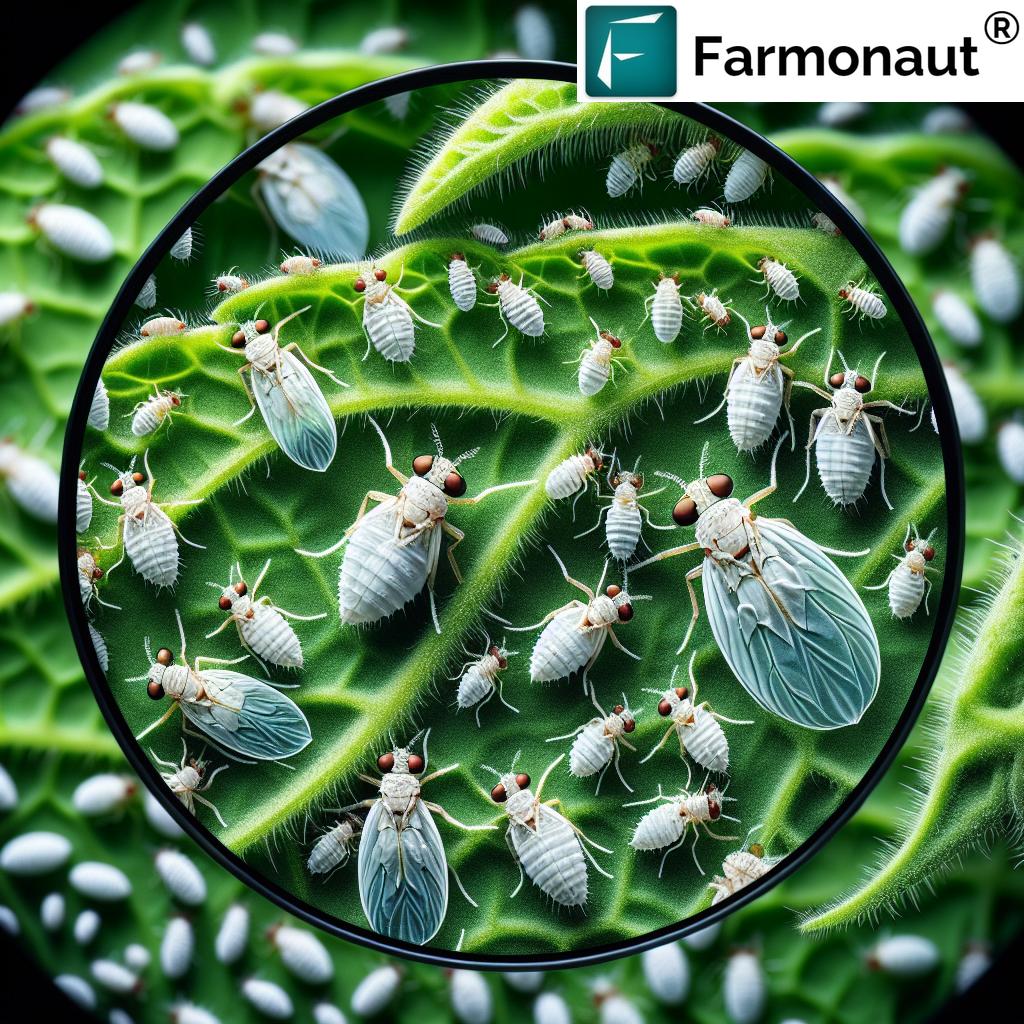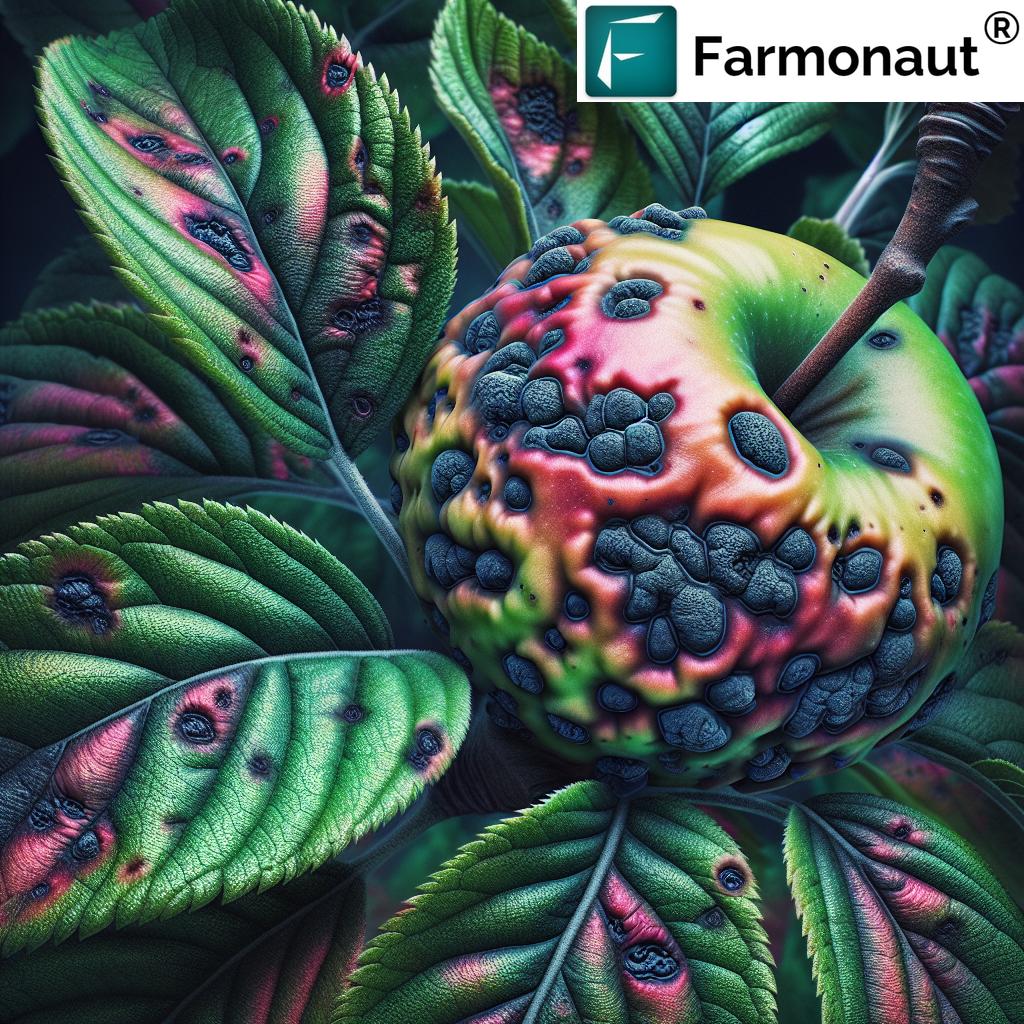Organic Whitefly Control: Protecting Your Crops from Bemisia tabaci

In the world of agriculture and horticulture, we constantly face challenges from various pests and diseases. One of the most persistent and damaging pests that farmers and gardeners encounter is the whitefly, particularly the species Bemisia tabaci. This tiny but formidable insect can wreak havoc on a wide range of crops, from tomatoes and peppers to cucurbits and cotton. In this comprehensive guide, we’ll explore effective organic control methods for whiteflies, with a focus on protecting your valuable crops from the destructive Bemisia tabaci.
Understanding the Whitefly: Bemisia tabaci
Before we delve into control methods, it’s crucial to understand our tiny adversary. Bemisia tabaci, commonly known as the silverleaf whitefly or sweet potato whitefly, is a species of whitefly that poses a significant threat to agriculture worldwide.
- Appearance: Adult whiteflies are tiny, winged insects, usually less than 1/16 inch long. They have a distinctive white, waxy coating on their wings and body.
- Life Cycle: The life cycle of Bemisia tabaci consists of egg, nymph, and adult stages. Females can lay up to 300 eggs in their lifetime.
- Host Range: This pest is incredibly adaptable and can infest over 500 plant species, including many important crops.
The Impact of Whiteflies on Crops
Whiteflies can cause significant damage to crops in several ways:
- Direct Feeding: Both adult and nymph whiteflies feed on plant sap, weakening the plant and reducing yields.
- Honeydew Production: As they feed, whiteflies excrete a sticky substance called honeydew, which can lead to the growth of sooty mold on leaves.
- Virus Transmission: Bemisia tabaci is known to transmit over 100 plant viruses, particularly begomoviruses, which can devastate entire crops.
- Physiological Disorders: Heavy infestations can cause leaf yellowing, stunted growth, and irregular ripening in fruits.
Crops Most Affected by Bemisia tabaci
While Bemisia tabaci has a wide host range, some crops are particularly susceptible to infestation and damage:
- Tomato: Whiteflies can cause significant yield losses and transmit viruses that affect fruit quality.
- Pepper: Both sweet and hot peppers are vulnerable to whitefly infestations.
- Cucurbitaceae Family: This includes crops like squash, melons, and cucumber, which are highly attractive to whiteflies.
- Brassica Crops: Broccoli, cauliflower, and cabbage can all suffer from whitefly damage.
- Cotton: A major host for Bemisia tabaci, often leading to significant economic losses.
- Other Susceptible Crops: Carrots, potato, and various herbs like basil and mint can also be affected.
Organic Control Strategies for Whitefly Management
At Farmonaut, we believe in promoting sustainable and environmentally friendly farming practices. Here are some effective organic control strategies for managing whitefly populations:
1. Cultural Control Methods
- Crop Rotation: Implementing a proper crop rotation system can help break the whitefly life cycle.
- Sanitation: Remove and destroy infected plant material to prevent the spread of whiteflies and associated viruses.
- Companion Planting: Utilize plants that repel whiteflies or attract beneficial insects that prey on them.
- Reflective Mulches: Use silver or aluminum-colored mulches to confuse and repel whiteflies.
2. Physical Control Methods
- Yellow Sticky Traps: These can help monitor and reduce adult whitefly populations.
- Row Covers: Use fine mesh covers to physically exclude whiteflies from your crops.
- Vacuuming: For small-scale operations, vacuuming adult whiteflies can be an effective control method.
3. Biological Control
Encouraging natural predators and parasitoids can be an effective long-term strategy for whitefly control:
- Predatory Insects: Ladybugs, lacewings, and predatory mites can help control whitefly populations.
- Parasitic Wasps: Tiny wasps like Encarsia formosa and Eretmocerus eremicus parasitize whitefly nymphs.
- Entomopathogenic Fungi: Certain fungi can infect and kill whiteflies, providing natural control.
4. Organic Pesticides
When other methods are insufficient, organic pesticides can be used as part of an integrated pest management strategy:
- Neem Oil: A natural insecticide that disrupts the feeding and reproduction of whiteflies.
- Insecticidal Soaps: These products can effectively control whitefly nymphs and soft-bodied adults.
- Pyrethrin: A natural insecticide derived from chrysanthemum flowers, effective against adult whiteflies.
- Horticultural Oils: These can smother whitefly eggs and nymphs when applied correctly.
Implementing an Integrated Pest Management (IPM) Approach
At Farmonaut, we advocate for an Integrated Pest Management (IPM) approach to whitefly control. This strategy combines various methods to manage pest populations effectively while minimizing environmental impact and reducing the risk of pesticide resistance.
Key Components of an IPM Strategy for Whitefly Control:
- Regular Monitoring: Consistently check your crops for signs of whitefly infestation. Early detection is crucial for effective control.
- Threshold-Based Action: Implement control measures only when whitefly populations reach damaging levels.
- Combination of Methods: Utilize a mix of cultural, physical, biological, and chemical control methods as needed.
- Preservation of Beneficial Insects: Choose control methods that minimize harm to natural predators and pollinators.
- Record Keeping: Maintain detailed records of pest populations, control measures used, and their effectiveness.
The Role of Technology in Whitefly Management
Modern technology plays a crucial role in enhancing our ability to detect and manage whitefly infestations. At Farmonaut, we leverage advanced satellite imagery and AI-driven analytics to provide farmers with powerful tools for pest management.
Satellite-Based Crop Monitoring
Our satellite-based crop monitoring system offers several advantages in the fight against whiteflies:
- Early Detection: Satellite imagery can detect changes in crop health before they’re visible to the naked eye, allowing for early intervention.
- Large-Scale Monitoring: Easily monitor vast areas of farmland for signs of pest infestation.
- Precise Treatment Application: Identify specific areas of infestation, enabling targeted and efficient pesticide application.
- Historical Data Analysis: Track pest patterns over time to predict future outbreaks and plan preventive measures.
To learn more about our satellite-based crop monitoring system, visit Farmonaut’s App.
AI-Powered Advisory System
Our Jeevn AI advisory system provides personalized recommendations for whitefly management based on real-time data:
- Customized Treatment Plans: Receive tailored advice on the most effective organic control methods for your specific situation.
- Timing Optimization: Get alerts on the best times to implement control measures based on pest life cycles and weather conditions.
- Integration with Weather Data: Our system combines pest monitoring with weather forecasts to optimize treatment efficacy.
Comparison: Whitefly Detection and Management with Farmonaut vs. Traditional Methods
| Aspect | Farmonaut’s Satellite System | Traditional Methods |
|---|---|---|
| Early Detection | Detects stress signals before visible symptoms appear | Relies on visual inspection, often detecting infestations late |
| Monitoring Infestation Spread | Covers large areas quickly, tracking spread patterns | Limited to manual scouting, time-consuming for large areas |
| Precision Treatment Application | Enables targeted treatment of affected areas | Often leads to blanket application of pesticides |
| Cost-Effectiveness | Reduces labor costs and optimizes resource use | Labor-intensive and potentially wasteful of resources |
Case Study: Organic Whitefly Control in Tomato Crops
To illustrate the effectiveness of organic whitefly control methods, let’s consider a case study of tomato crops, which are particularly susceptible to Bemisia tabaci infestations.
The Challenge
A small organic farm in California was experiencing recurring whitefly infestations in their tomato crops. The farmers were concerned about yield losses and the potential spread of tomato yellow leaf curl virus (TYLCV), a begomovirus transmitted by whiteflies.
The Approach
The farmers implemented a multi-faceted organic control strategy:
- Cultural Controls:
- Implemented a crop rotation plan, avoiding susceptible crops in adjacent fields.
- Used reflective silver mulch between rows to repel whiteflies.
- Practiced strict field sanitation, removing and destroying infected plant material.
- Physical Controls:
- Installed yellow sticky traps around the field perimeter and within the crop.
- Used row covers during the early growth stages to protect young plants.
- Biological Controls:
- Released predatory insects, including ladybugs and lacewings, into the field.
- Introduced parasitic wasps (Encarsia formosa) to target whitefly nymphs.
- Organic Pesticides:
- Applied neem oil treatments when whitefly populations reached threshold levels.
- Used insecticidal soaps for spot treatments of heavy infestations.
- Monitoring and Technology:
- Utilized Farmonaut’s satellite-based crop monitoring system to detect early signs of infestation.
- Employed the Jeevn AI advisory system for personalized treatment recommendations.
The Results
After implementing this integrated organic control strategy:
- Whitefly populations were significantly reduced within 4-6 weeks.
- The incidence of TYLCV in the tomato crop decreased by 80% compared to the previous season.
- Tomato yields increased by 25% due to reduced pest pressure and improved plant health.
- The farm saw a 30% reduction in pesticide use, leading to cost savings and environmental benefits.
- Beneficial insect populations in and around the field increased, providing long-term pest control benefits.
This case study demonstrates the effectiveness of a well-planned, integrated organic approach to whitefly control, enhanced by modern technology like Farmonaut’s satellite monitoring and AI advisory systems.
Best Practices for Organic Whitefly Control
Based on our experience and scientific research, we recommend the following best practices for organic whitefly control:
- Prevention is Key: Implement cultural and physical control methods proactively to prevent whitefly infestations from taking hold.
- Diversity in Control Methods: Don’t rely on a single control method. Combine various organic strategies for the most effective results.
- Regular Monitoring: Consistently check your crops for signs of whitefly activity. Early detection is crucial for successful control.
- Timing is Everything: Apply control measures when whiteflies are most vulnerable, typically in their egg and nymph stages.
- Protect Beneficial Insects: Choose organic pesticides that minimally impact natural predators and pollinators.
- Proper Application: When using organic pesticides, ensure thorough coverage, especially on the undersides of leaves where whiteflies tend to congregate.
- Resistance Management: Rotate between different organic control methods to prevent whiteflies from developing resistance.
- Holistic Approach: Consider the entire ecosystem of your farm or garden. Healthy plants in a balanced environment are more resistant to pest infestations.
- Continuous Learning: Stay informed about the latest research and techniques in organic pest control. The field is constantly evolving.
- Leverage Technology: Utilize modern tools like Farmonaut’s satellite monitoring and AI advisory systems to enhance your pest management strategies.
The Future of Organic Whitefly Control
As we look to the future, several promising developments are on the horizon for organic whitefly control:
1. Advanced Biological Control Agents
Researchers are continually discovering and developing new biological control agents that are even more effective against whiteflies. These may include:
- Novel strains of entomopathogenic fungi specifically targeted at Bemisia tabaci.
- Genetically enhanced predatory insects with improved whitefly-hunting capabilities.
- Biopesticides derived from plant extracts with potent anti-whitefly properties.
2. Precision Agriculture and IoT
The integration of Internet of Things (IoT) devices with precision agriculture techniques will revolutionize whitefly control:
- Smart traps that automatically count and identify whitefly species, sending real-time data to farmers.
- Drone-based pest monitoring and targeted organic pesticide application.
- AI-powered decision support systems that integrate data from multiple sources to provide highly accurate pest management recommendations.
3. Plant Breeding and Biotechnology
Advancements in plant breeding and biotechnology will lead to:
- Development of crop varieties with enhanced natural resistance to whiteflies and associated viruses.
- Plants engineered to produce natural compounds that repel or disrupt whitefly feeding and reproduction.
4. Nanotechnology in Pest Control
The application of nanotechnology in agriculture will open new avenues for whitefly control:
- Nanoencapsulation of organic pesticides for improved efficacy and reduced environmental impact.
- Nano-sensors for early detection of whitefly infestations at the molecular level.
5. Climate Change Adaptation
As climate change affects pest distributions and behaviors, we’ll see:
- Development of predictive models that account for changing climate patterns to forecast whitefly outbreaks.
- Adaptation of control strategies to suit new climate realities in different regions.
Conclusion: A Holistic Approach to Whitefly Management
Effective organic control of whiteflies, particularly Bemisia tabaci, requires a comprehensive and integrated approach. By combining cultural, physical, and biological control methods with judicious use of organic pesticides, farmers and gardeners can successfully manage whitefly populations while maintaining the health of their crops and the environment.
At Farmonaut, we’re committed to supporting sustainable agriculture through innovative technology. Our satellite-based crop monitoring system and AI-powered advisory tools provide valuable insights for pest management, enabling more efficient and effective organic whitefly control strategies.
Remember, the key to successful whitefly management lies in prevention, early detection, and a balanced approach that works in harmony with nature. By staying informed, utilizing modern technology, and implementing best practices, we can protect our crops from whiteflies while promoting a healthier, more sustainable agricultural ecosystem.
FAQs
-
Q: How can I tell if my plants are infested with whiteflies?
A: Look for small, white flying insects on the undersides of leaves. You may also notice yellowing leaves, sticky honeydew, or the presence of sooty mold. -
Q: Are whiteflies harmful to humans?
A: Whiteflies are not directly harmful to humans, but they can cause significant damage to crops and plants. -
Q: How often should I monitor my crops for whiteflies?
A: Regular monitoring is crucial. We recommend checking your crops at least once a week, or more frequently during peak whitefly season. -
Q: Can whiteflies survive winter?
A: In warmer climates, whiteflies can survive year-round. In colder regions, they may overwinter in greenhouses or on protected plants. -
Q: Are there any plants that repel whiteflies?
A: Yes, certain plants like marigolds, nasturtiums, and basil are known to repel whiteflies and can be used as companion plants. -
Q: How does Farmonaut’s technology help in whitefly control?
A: Our satellite-based crop monitoring system can detect early signs of infestation, while our AI advisory system provides personalized recommendations for effective control strategies. -
Q: Is it possible to completely eradicate whiteflies from my farm?
A: Complete eradication is challenging and often unrealistic. The goal should be to manage whitefly populations below damaging levels through integrated pest management strategies. -
Q: How can I prevent whiteflies from developing resistance to organic pesticides?
A: Rotate between different control methods and avoid overusing any single pesticide. Integrated pest management helps prevent resistance development. -
Q: Are organic control methods as effective as conventional chemical pesticides?
A: When implemented correctly as part of an integrated approach, organic control methods can be just as effective as conventional pesticides, with the added benefits of being environmentally friendly and sustainable. -
Q: How can I get started with Farmonaut’s crop monitoring system?
A: You can sign up for our services through our website or mobile app. Visit Farmonaut’s App to get started.
Ready to take your whitefly control to the next level? Subscribe to Farmonaut’s services and harness the power of satellite technology for effective pest management:
For more information on our API services, visit our API documentation. Download our mobile app for on-the-go crop monitoring:
For detailed technical information, check out our Satellite Weather API Developer Docs.














